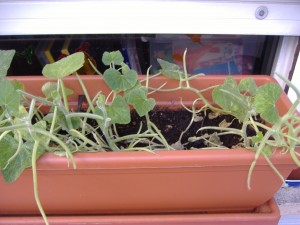A few days ago I wrote a brief post about natural selection and breeding. In essence, can human breeders achieve what natural selection has not, like turn rice into a species that uses the C4 photosynthesis pathway. Ford Denison, whose blog post I was quoting, weighed in not only to agree about C4, but also to point to another recent post of his, The bitter fountain of youth. In this, Denison expands on a paper in which he and colleagues showed that if food is scarce, it may pay 1 to swap early reproduction for a longer life. What has all this to do with agricultural biodiversity?
Because, as Denison pointed out, many components of a diverse diet have tastes and odours that could be associated with times of famine, times when it would be a good evolutionary strategy to delay reproduction and increase longevity.
Past population declines were often caused by shortages of food, which can affect both the amount and types of food eaten. For example, natural insecticides in plants often have an unpleasant taste. Over most of our evolutionary history, therefore, these plants may have been eaten only when preferred foods, like meat or fruit, were not available. Consumption of these “famine foods” would therefore have been a reasonably good predictor of population decline, so they may trigger physiological changes (lower testosterone, etc.) that increase longevity while tending to delay reproduction.
A remarkable result, seen in both nematode worms and fruit flies, is that food odors can reverse the beneficial effects of dietary restriction on longevity (Libert, et al. 2007). If an individual smells food, others may be eating that food, so population size may be increasing. In that case, delaying reproduction would be a losing strategy, even if reproducing now increases the chance of an early death.
What about humans? Our models assumed that individuals reproduce only once, then die, like salmon or soybeans. However, we expect that some of our results will apply to species, like humans, with more complex life histories. One result for humans that is consistent with our hypothesis is that artificially sweetened soft drinks are just as likely to cause metabolic syndrome (related to diabetes) as sugared soft drinks are (Lutsey, et al. 2008). Like food odors, sweet foods may have been correlated, over much of our evolutionary history, with abundance, and therefore with impending increases in population size. If we want to live longer, maybe we should instead eat foods whose chemical composition or flavor remind our bodies of past famines. The health benefits we get from eating vegetables like kale may be due, in part, to the chemicals that give them their slightly bitter taste.
The idea that our preferences and appetites were shaped some time ago is a common one, and in diet gives rise to ideas like the Pleistocene Diet. As Ford commented, his theory suggests a new explanation, for humans, of chemicals plants make to defend themselves against insects, the very chemicals that breeders are trying to increase in some varieties.
Penny, however, was not convinced.
Indigenous diets are often far more diverse in the range of flavors they seek out. They recognize flavors that in the western context, we would interpret purely as smells and include foods that are intentionally bitter, sour, astringent (ie. under ripe bananas), spicey, hot (as in creating heat), rich (oily or high in protein), bland, sweet, salty, pungent (like durian), what we might call foetid or just plain stinky (a sour green sort of smell-taste), and “off” (ie. turned the freshness corner or moulded) along with a few others.
She thinks that the westerners’ preferences are the result of reduced dietary diversity and “corporate food producers and plant breeders making ‘sweet’ junkies out of the city masses”.
Things then get a little out of hand, but I think they’re both correct. It was easy to turn us into “sweet” (and salty, and fatty) junkies precisely because those food elements were rare in our evolutionary history, and so there was no evolutionary advantage to be gained by turning them down, when available. Hence, we don’t know when to stop.
For me, some of the proof of that lies in the fact that indigenous cultures, confronted with a superabundance of sweet, salty and fatty foods are no better than the rest of us at resisting their appeal.
While I’m about it, I wonder how Denison’s idea of bitter tastes being a famine signal relates to the science behind Seth Roberts’ Shangri La diet? Both notions depend on associations being formed between the availability of calories and specific flavours and tastes. Are they even aware of one another? Maybe this post will make them so.
Anyway, my own lunch (bitter, fatty, spicy) calls, so with a quiet “ramen,” I’ll leave the last word to Ford Denison, a genuine, working scientist who is not afraid to blog:
On the other hand, evolution is an ongoing process, so I don’t exclude the possibility that different human groups might respond differently.
